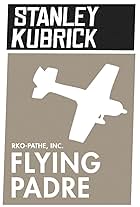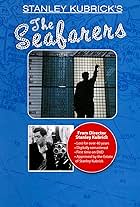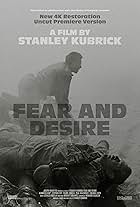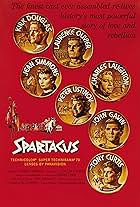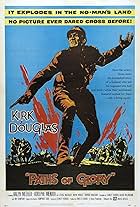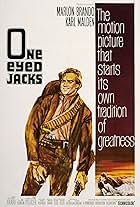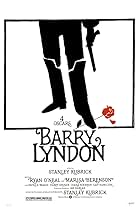IMDb RATING
6.2/10
5.3K
YOUR RATING
After a short study of boxing's history, narrated by newscaster Douglas Edwards, we follow a day in the life of a middleweight Irish boxer named Walter Cartier.After a short study of boxing's history, narrated by newscaster Douglas Edwards, we follow a day in the life of a middleweight Irish boxer named Walter Cartier.After a short study of boxing's history, narrated by newscaster Douglas Edwards, we follow a day in the life of a middleweight Irish boxer named Walter Cartier.
Judy Singer
- Self - Female Fan in Crowd
- (uncredited)
- Director
- Writer
- All cast & crew
- Production, box office & more at IMDbPro
Storyline
Did you know
- TriviaIt cost Stanley Kubrick $3,900 to make and he sold it (to RKO) for $4,000.
- Alternate versionsWhen RKO obtained the film for their "This Is America" series, they added about four minutes of new material to the beginning of the film, making the short 16 minutes long instead of the original 12 minutes. The opening four minutes with boxing historian Nat Fleischer is markedly different from the rest of the film as if features footage from different boxing matches. The opening was also modified with the credits appearing in different order and the music for the opening was also changed. The majority of the picture is the same until the end. In the last sequence when the knock out happens, the narration is once again changes. Kubrick's original cut features Douglas Edwards talking about personal sacrifice and success. The extended RKO cut removes this portion of the narration and adds new one with Nat Fleischer to better match the opening segment - this narration is about how this fight will go down into the record books. The music at the end was also changed - Gerald Fried's finale cue was moved earlier to match the beginning of the new narration, but because it starts sooner, it doesn't line up with the ending. Thus the new end title card (which adds This is America to the bottom of the card) plays in silence.
- ConnectionsFeatured in The Art of Stanley Kubrick: From Short Films to Strangelove (2000)
Featured review
In 1950, legendary director Stanley Kubrick was a young photographer who was beginning to be fascinated by the many films he discovered in his visits to the screenings done by the Museum of Modern Art and other cinemas of New York. The discovery of such a wide range of different films made a big impact on the talented "Look" magazine photographer, who began to experiment with the medium, heavily influenced by the fluid movement that was the trademark of director Max Ophüls' work. It was that very same year when Kubrick would have his first chance to make a movie, as his friend Alexander Singer persuaded him to make a short documentary that he could sell to a distributor of cinema newsreels. Kubrick accepted the proposal, and inspired by an article he had done for "Look", he began working on his first movie. That early film would be "Day of the Fight".
"Day of the Fight" is a short documentary that chronicles a day in the life of Irish middleweight boxer Walter Cartier, a very promising fighter who is about to face an important contender, Bobby James, on that very same day. However, before focusing on Cartier, the movie makes a short yet informative description of boxing, its history, and its fanatics; everything with the precise and direct narration by veteran newsman Douglas Edwards. After that brief introduction, the movie follows Cartier from early in the morning until the fight, which takes place at 10:00 pm. Through the day, we follow Walter Cartier and his identical twin brother Vincent (who is also a lawyer and Walter's manager) in their preparation for the fight, starting with a good breakfast and early mass, and the subsequent mental and physical preparation that Walter makes in order to become a fighting machine.
While the idea of the film was entirely Kubrick's, the screenplay for the narration was entirely the work of Robert Rein, who follows the typical style of narrative that had been prevalent during the 40s weekly newsreels of "The March of Time", as in fact, that company was the originally planned buyer of "Day of Fight. However, since the company went out of business that very same year, the movie was then sold to RKO Pictures, who under the RKO-Pathé brand, became the movie's distributor. Anyways, as written above, Rein's script follows the classic conventions of the newsreels of its time, mixing the educational purposes of the documentary with a heavy use of melodramatics in the voice-over's narrative. However, credit must go to Rein for making a very realistic, albeit sentimentalist, description of the boxers' life.
If the voice-over of "Day of the Fight" sounds archaic and outdated to us these days, Kubrick's direction of the film looks the opposite as while still limited to its medium's restriction, the young director managed to create a vibrant film thanks to his very fluid and dynamic use of camera-work. While the movie is still a documentary bounded by its obligatory narration, Kubrick uses his camera to create a character out of the real persona of Walter Cartier, and while the boxer has no lines in the movie, a lot of him can be known thanks to the images Kubrick's camera has captured of him. As the moment of the fight gets closer, Kubrick accelerates the pace, truly increasing the tension and giving the story a real feeling of suspense as the fight begins. The images from the fight are remarkably edited and the result is one of the best scenes of a sports documentary.
While the screenplay is definitely typical of newsreels, Douglas Edwards' narration gives it a slightly different edge, as he manages to put the perfect emotion on what he is saying. No doubt thanks to his many years as a sports newsman, Edwards gives his words an impact and presence that makes the movie real, as if one was there with Cartier training for the big day. True, it's still an outdated style of narration, but Edwards' style makes it enjoyable. The rest of the people who appears on film has no lines, while we follow the Cartier brothers in their day, everything is narrated by Edwards and there is no interview with the contenders. However, it's safe to say that in this movie Walter projects a lot of presence and so it's not a surprise that after his career as a boxer he had decided to become an actor (landing a small, yet memorable role in "The Phil Silvers Show").
Considering the magnitude and importance of Stanley Kubrick's career, it's very easy to dismiss this movie as part of his career; however, unlike his second work ("The Flying Padre"), there are many things in this movie that makes it interesting and showcase early bits of what would become the Kubrick's style. Sure, it has every flaw a newsreel could have (including the typical use of staged scenes), but it also feels different, as Kubrick's eye for photography gave it a new look (Certainly, Gerald Fried's music also helped on this). A short newsreel like "Day of the Fight" may not be the most impressive debut for a legendary filmmaker, but in all its humility, this little short represents the beginning of a Master's career, and that's enough reason to give it a chance. Kubrick fans, this is a must. 7/10
"Day of the Fight" is a short documentary that chronicles a day in the life of Irish middleweight boxer Walter Cartier, a very promising fighter who is about to face an important contender, Bobby James, on that very same day. However, before focusing on Cartier, the movie makes a short yet informative description of boxing, its history, and its fanatics; everything with the precise and direct narration by veteran newsman Douglas Edwards. After that brief introduction, the movie follows Cartier from early in the morning until the fight, which takes place at 10:00 pm. Through the day, we follow Walter Cartier and his identical twin brother Vincent (who is also a lawyer and Walter's manager) in their preparation for the fight, starting with a good breakfast and early mass, and the subsequent mental and physical preparation that Walter makes in order to become a fighting machine.
While the idea of the film was entirely Kubrick's, the screenplay for the narration was entirely the work of Robert Rein, who follows the typical style of narrative that had been prevalent during the 40s weekly newsreels of "The March of Time", as in fact, that company was the originally planned buyer of "Day of Fight. However, since the company went out of business that very same year, the movie was then sold to RKO Pictures, who under the RKO-Pathé brand, became the movie's distributor. Anyways, as written above, Rein's script follows the classic conventions of the newsreels of its time, mixing the educational purposes of the documentary with a heavy use of melodramatics in the voice-over's narrative. However, credit must go to Rein for making a very realistic, albeit sentimentalist, description of the boxers' life.
If the voice-over of "Day of the Fight" sounds archaic and outdated to us these days, Kubrick's direction of the film looks the opposite as while still limited to its medium's restriction, the young director managed to create a vibrant film thanks to his very fluid and dynamic use of camera-work. While the movie is still a documentary bounded by its obligatory narration, Kubrick uses his camera to create a character out of the real persona of Walter Cartier, and while the boxer has no lines in the movie, a lot of him can be known thanks to the images Kubrick's camera has captured of him. As the moment of the fight gets closer, Kubrick accelerates the pace, truly increasing the tension and giving the story a real feeling of suspense as the fight begins. The images from the fight are remarkably edited and the result is one of the best scenes of a sports documentary.
While the screenplay is definitely typical of newsreels, Douglas Edwards' narration gives it a slightly different edge, as he manages to put the perfect emotion on what he is saying. No doubt thanks to his many years as a sports newsman, Edwards gives his words an impact and presence that makes the movie real, as if one was there with Cartier training for the big day. True, it's still an outdated style of narration, but Edwards' style makes it enjoyable. The rest of the people who appears on film has no lines, while we follow the Cartier brothers in their day, everything is narrated by Edwards and there is no interview with the contenders. However, it's safe to say that in this movie Walter projects a lot of presence and so it's not a surprise that after his career as a boxer he had decided to become an actor (landing a small, yet memorable role in "The Phil Silvers Show").
Considering the magnitude and importance of Stanley Kubrick's career, it's very easy to dismiss this movie as part of his career; however, unlike his second work ("The Flying Padre"), there are many things in this movie that makes it interesting and showcase early bits of what would become the Kubrick's style. Sure, it has every flaw a newsreel could have (including the typical use of staged scenes), but it also feels different, as Kubrick's eye for photography gave it a new look (Certainly, Gerald Fried's music also helped on this). A short newsreel like "Day of the Fight" may not be the most impressive debut for a legendary filmmaker, but in all its humility, this little short represents the beginning of a Master's career, and that's enough reason to give it a chance. Kubrick fans, this is a must. 7/10
Details
- Release date
- Country of origin
- Language
- Also known as
- Day of the fight (Día de combate)
- Filming locations
- Church of St. Francis Xavier, 46 W. 16th St., New York City, New York, USA(Church where Walter Cartier and his brother, Vincent, attend morning mass)
- Production company
- See more company credits at IMDbPro
Box office
- Budget
- $3,900 (estimated)
- Runtime16 minutes
- Color
- Aspect ratio
- 1.37 : 1
Contribute to this page
Suggest an edit or add missing content












